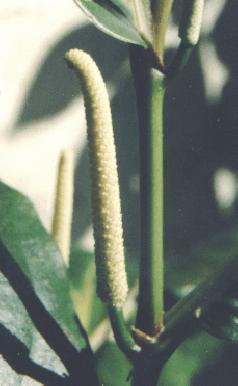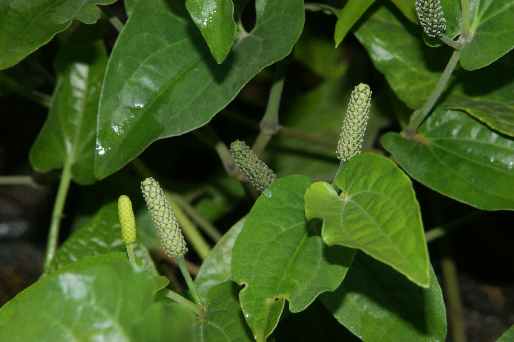
|
|
Long pepper, flowering plant (P. longum)
|

|
|
Flower of Indian long pepper (P. longum)
|
Long pepper probably came to Europe before the now dominant
black pepper. It was highly priced during the Roman
Empire — about three times the price of black pepper. With its taste pungent
and sweet at the same time, it was perfect for Roman cookery especially fond of
these two taste sensations (see
silphion for
details). In our days, long pepper is nearly unknown and sometimes hard to
obtain.
Since terpene components are missing from its aroma, long pepper cannot be
substituted by ordinary black pepper (you may try white pepper plus a little
bit of mace, though). Its hot–and–sweet taste goes
well with spicy cheese specialties (it’s a secret
of my personal cheese
fondue mixture) or wine sauces.
In Asia, two different plants with exactly the same sensory properties are
used: Piper retrofractum from Indonesia has rods a little bit
smaller than Piper longum from India (Bengal pepper). In
Western countries, mostly the latter is available.
Since long pepper is more pungent than black pepper, it must be used with care,
unless you like fiery food. Crush the rods before use. In India, the main
application for long pepper is its usage in spicy vegetable pickles
(in Hindi, achar [अचार]).
Rather remarkably, long pepper is also known and popular in parts of Africa,
namely in the Islâmic regions of North and East Africa, whereto it has
been introduced by Arab traders. Therefore, long pepper is sometimes found in
the complex spice mixtures of Morocco (ras el hanout, see cubeb pepper); but it is also of some importance for
the cuisine of Ethiopia, where long pepper is usually found in the traditional
meat stews (wat), mostly together with black pepper, nutmeg, cloves and turmeric; the
usage of turmeric exemplifies Indian influence in Ethiopian cuisine. Popular
recipes are siga wat [ስጋ ወጥ], lean beef cubes
braised in a spicy, thick gravy made from chiles,
onions and garlic,
and doro wat [ዶሮ ወጥ],
a stew of chicken and hard-boiled eggs in similar gravy. Besides rice, the
main staple in East Africa is a thin leavened bread (injera [እንጀራ]),
which is made from a local cereal, teff [ጤፍ] (Eragrostis tef).

|
|
Flowering long pepper
|
Spice usage in Ethiopia parallels Indian tradition in several ways: Clarified butter
(niter kibbi [ንጥር ቅቤ])
is a common ingredient; other than Indian ghi, the Ethiopian
version is prepared with spices and more often used as a flavouring than as
a cooking medium.
Also, the classical Ethiopian spice mixture berbere
(also spelt berebere) resembles Indian masalas
(see cumin) not only in its list of ingredients, but
also in its preparation process which includes dry toasting of ingredients.
In Ethiopia, the term berbere [በርበሬ] refers
to both a coarse powder of semihot to hot chiles
and to a spice mixture (flavoured berbere
) which
contains chiles as the main ingredient.
Berbere mixture is rather hot
and traditionally used to spice mutton dishes; it is made by toasting dry chiles a few minutes until they darken and subsequent
adding of long and black pepper, ginger, coriander fruits,
fenugreek and a little bit of ajwain. Sweet tones are achieved by cinnamon, cardamom seeds,
cloves and even allspice. Another ingredient, often omitted in recipes
designed for the Western market, is rue, either
in form of fresh leaves or as fresh or dried fruits.
Berbere can be made into a paste with water, wine or
mead (tej [ጠጅ]); such
a paste, called awaze or awazi [አዋዜ],
is usually served as a table condiment. The paste can again be dried at
elevated temperature to yield an even more aromatic spice. Some very complex
berbere recipes consist of repeated steps of moistening and
drying; the more delicate ingredient (rue leaves,
basil) are added only before the last step.
Ethiopia’s small neighbour Eritrea features a related cuisine which, however,
acquires a distict character by the use of Mediterranean ingredients (e. g.,
pasta) and herbs, which had been introduced during the
Italian colonial era. The basic condiment is berbere paste prepared
similar to the Ethiopian version, but with less chile;
dried onions provide the typical Eritrean flavour.
Example of Eritrean foods are the chicken stew tsebhi dorho [ጸብሒ ደርሆ]
and a similar beef stew, zigni [ዝግኒ].
Eritrean flat bread ingera [እንጌራ]
is, as its Ethiopian counterpart, made from teff or a teff–wheat-blend, but is has a milder
taste due to lesser fermentation.








